Trane IntelliPak I, IntelliPak II Programming Guide
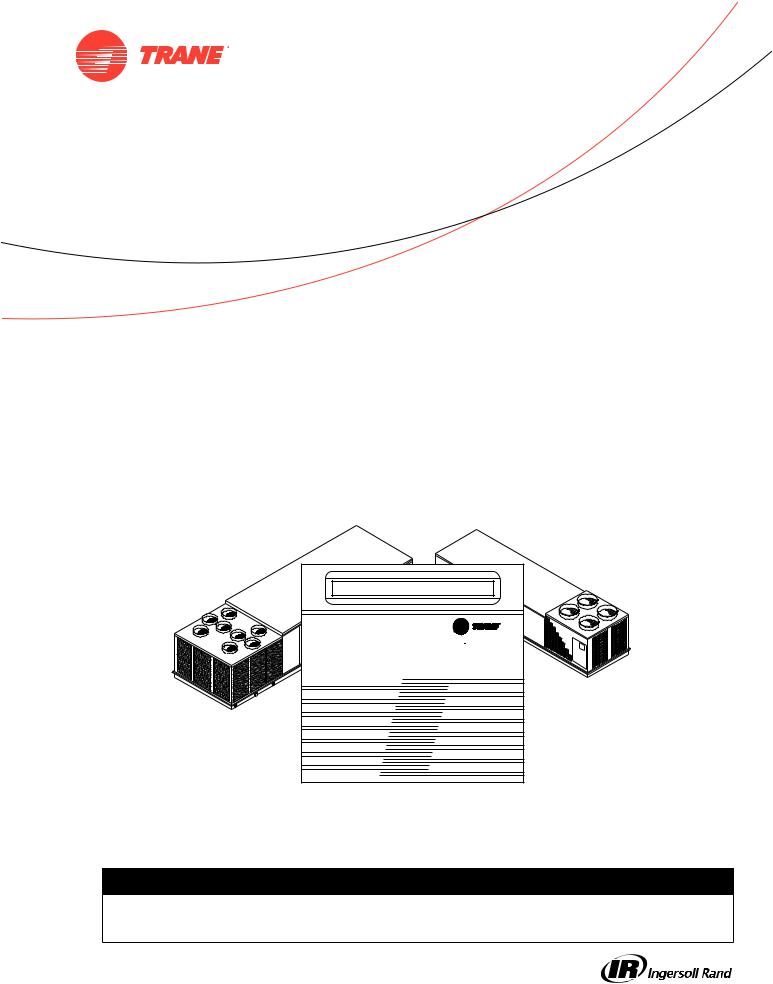
Programming &
Troubleshooting
Guide
IntelliPak™ I and IntelliPak™ II
Commercial Single Zone Rooftop Air Conditioner or Commercial Rooftop Air Handlers, with Variable Air Volume (VVDA/VVZT) Controls or Constant Air Volume (CVDA/CVZT) Controls
IntelliPak I models |
S*HF*20-75 |
S*HL*20-75 |
|
S*HG*90-130 |
S*HK*90-130 W*HB, W*HE |
IntelliPak II models |
S*HJ090-162 |
W*HCA-C |
 SAFETY WARNING
SAFETY WARNING
Only qualified personnel should install and service the equipment. The installation, starting up, and servicing of heating, ventilating, and airconditioning equipment can be hazardous and requires specific knowledge and training. Improperly installed, adjusted or altered equipment by an unqualified person could result in death or serious injury. When working on the equipment, observe all precautions in the literature and on the tags, stickers, and labels that are attached to the equipment.
July 2014 |
RT-SVP07D-EN |
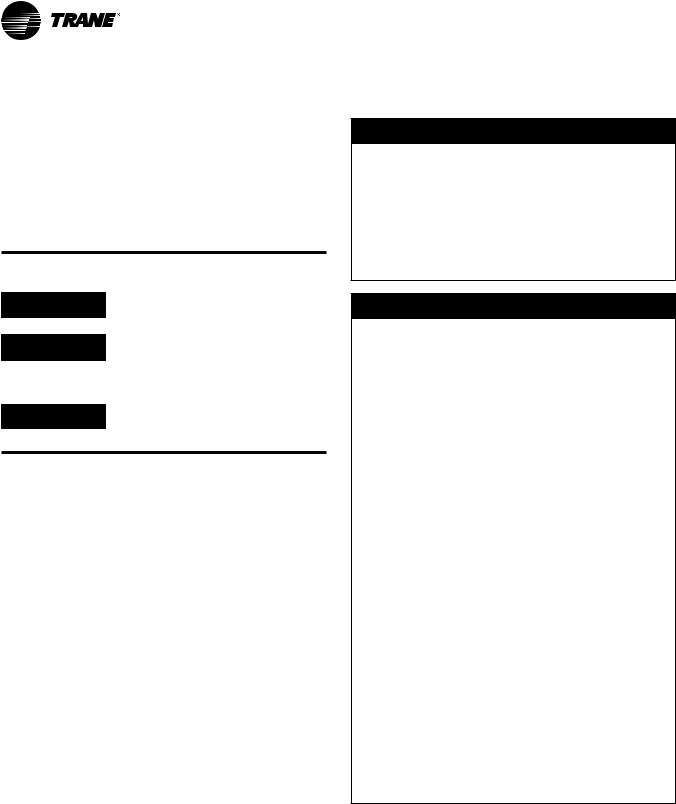
Introduction
Read this manual thoroughly before operating or servicing this unit.
Warnings, Cautions, and Notices
Safety advisories appear throughout this manual as required.Your personal safety and the proper operation of this machine depend upon the strict observance of these precautions.
The three types of advisories are defined as follows:
 WARNING
WARNING
 CAUTIONs
CAUTIONs
NOTICE
Indicates a potentially hazardous situation which, if not avoided, could result in death or serious injury.
Indicates a potentially hazardous situation which, if not avoided, could result in minor or moderate injury. It could also be used to alert against unsafe practices.
Indicates a situation that could result in equipment or property-damage only accidents.
Important Environmental Concerns
Scientific research has shown that certain man-made chemicals can affect the earth’s naturally occurring stratospheric ozone layer when released to the atmosphere. In particular, several of the identified chemicals that may affect the ozone layer are refrigerants that contain Chlorine, Fluorine and Carbon (CFCs) and those containing Hydrogen, Chlorine, Fluorine and Carbon (HCFCs). Not all refrigerants containing these compounds have the same potential impact to the environment.Trane advocates the responsible handling of all refrigerants-including industry replacements for CFCs such as HCFCs and HFCs.
Important Responsible Refrigerant
Practices
Trane believes that responsible refrigerant practices are important to the environment, our customers, and the air conditioning industry. All technicians who handle refrigerants must be certified.The Federal Clean Air Act (Section 608) sets forth the requirements for handling, reclaiming, recovering and recycling of certain refrigerants and the equipment that is used in these service procedures. In addition, some states or municipalities may have additional requirements that must also be adhered to for responsible management of refrigerants. Know the applicable laws and follow them.
 WARNING
WARNING
Proper Field Wiring and Grounding
Required!
Failure to follow code could result in death or serious injury. All field wiring MUST be performed by qualified personnel. Improperly installed and grounded field wiring poses FIRE and ELECTROCUTION hazards. To avoid these hazards, you MUST follow requirements for field wiring installation and grounding as described in NEC and your local/state electrical codes.
 WARNING
WARNING
Personal Protective Equipment (PPE)
Required!
Installing/servicing this unit could result in exposure to electrical, mechanical and chemical hazards.
•Before installing/servicing this unit, technicians MUST put on all PPE required for the work being undertaken (Examples; cut resistant gloves/sleeves, butyl gloves, safety glasses, hard hat/bump cap, fall protection, electrical PPE and arc flash clothing). ALWAYS refer to appropriate Material Safety Data Sheets (MSDS)/Safety Data Sheets (SDS) and OSHA guidelines for proper PPE.
•When working with or around hazardous chemicals, ALWAYS refer to the appropriate MSDS/SDS and OSHA/GHS (Global Harmonized System of Classification and Labelling of Chemicals) guidelines for information on allowable personal exposure levels, proper respiratory protection and handling instructions.
•If there is a risk of energized electrical contact, arc, or
flash, technicians MUST put on all PPE in accordance with OSHA, NFPA 70E, or other country-specific requirements for arc flash protection, PRIOR to servicing the unit. NEVER PERFORM ANY SWITCHING, DISCONNECTING, OR VOLTAGE TESTING WITHOUT PROPER ELECTRICAL PPE AND ARC FLASH CLOTHING. ENSURE ELECTRICAL METERS AND EQUIPMENT ARE PROPERLY RATED FOR INTENDED VOLTAGE.
Failure to follow instructions could result in death or serious injury.
© 2014Trane All rights reserved |
RT-SVP07D-EN |

Introduction
Copyright
This document and the information in it are the property of Trane, and may not be used or reproduced in whole or in part without written permission.Trane reserves the right to revise this publication at any time, and to make changes to its content without obligation to notify any person of such revision or change.
Trademarks
All trademarks referenced in this document are the trademarks of their respective owners.
Revision History
•Minor running edits.
•Addition of “Fault Detection and Diagnostics.,” p. 7
•Addition of configuration screen details in “CONFIGURATION Menu,” p. 98
•Addition of testing and troubleshooting details in “SERVICE MODE Menu (Local Human Interface only),” p. 107
•Additional values added to Active Diagnostic - Auto Reset, see p. 118.
RT-SVP07D-EN |
3 |

Table of Contents |
|
Introduction . . . . . . . . . . . . . . . . . . . . . . . . . . . . . . . . . . . . . . . . . . . . . . . . . . . . . . . . . . . . |
2 |
Warnings, Cautions, and Notices . . . . . . . . . . . . . . . . . . . . . . . . . . . . . . . . . . . . . |
2 |
Copyright . . . . . . . . . . . . . . . . . . . . . . . . . . . . . . . . . . . . . . . . . . . . . . . . . . . . . . . . . |
3 |
Commonly Used Acronyms . . . . . . . . . . . . . . . . . . . . . . . . . . . . . . . . . . . . . . . . . . . . . 5
Glossary of Terms . . . . . . . . . . . . . . . . . . . . . . . . . . . . . . . . . . . . . . . . . . . . . . . . . 6
Menu Keys . . . . . . . . . . . . . . . . . . . . . . . . . . . . . . . . . . . . . . . . . . . . . . . . . . . . . . . 11
Data Manipulation Keys . . . . . . . . . . . . . . . . . . . . . . . . . . . . . . . . . . . . . . . . . . . 12
Unit Operation Keys . . . . . . . . . . . . . . . . . . . . . . . . . . . . . . . . . . . . . . . . . . . . . . . . . . . 13
General Status Display . . . . . . . . . . . . . . . . . . . . . . . . . . . . . . . . . . . . . . . . . . . . . . . . . 13
STATUS Menu . . . . . . . . . . . . . . . . . . . . . . . . . . . . . . . . . . . . . . . . . . . . . . . . . . . . . . . . 26
SETUP Menu . . . . . . . . . . . . . . . . . . . . . . . . . . . . . . . . . . . . . . . . . . . . . . . . . . . . . . . . . . 54
Emergency Override Definitions (with LCI or BCI module installed) . . . . . . 66
SETPOINT Menu . . . . . . . . . . . . . . . . . . . . . . . . . . . . . . . . . . . . . . . . . . . . . . . . . . . . . . 86
CONFIGURATION Menu . . . . . . . . . . . . . . . . . . . . . . . . . . . . . . . . . . . . . . . . . . . . . . . . 98
SERVICE MODE Menu (Local Human Interface only) . . . . . . . . . . . . . . . . . . . . . 107
DIAGNOSTICS Menu . . . . . . . . . . . . . . . . . . . . . . . . . . . . . . . . . . . . . . . . . . . . . . . . . |
116 |
Diagnostics . . . . . . . . . . . . . . . . . . . . . . . . . . . . . . . . . . . . . . . . . . . . . . . . . . . . . |
122 |
Module Input / Output Descriptions . . . . . . . . . . . . . . . . . . . . . . . . . . . . . . . . |
150 |
Index . . . . . . . . . . . . . . . . . . . . . . . . . . . . . . . . . . . . . . . . . . . . . . . . . . . . . . . . . . . . . . . . 154
4 |
RT-SVP07D-EN |

Commonly Used Acronyms
For convenience, a number of acronyms and abbreviations are used throughout this manual.These acronyms are alphabetically listed and defined below.
Table 1. Acronyms
act = active, actuator |
IGV = inlet guide vanes |
|
|
AH = air handler |
Indep = Independent |
|
|
annunc = annunciate |
INFO = Information Only (Diagnostic) |
|
|
AS = airside |
I/O = input/output |
|
|
aux = auxiliary |
IOM = installation/operation/ maintenance manual |
|
|
BAS = Building Automation System |
IPAK = IntelliPak I™, IntelliPak II™ |
|
|
BCI = BACnet® Communication Interface Module |
IPC = interprocessor communications |
ccfm = cfm/100 (ex. 120.5 CCFM = 12050 CFM) |
IPCB = Interprocessor Communications Bridge (mod) |
|
|
cfm = cubic-feet-per-minute |
iwc = inches water column |
|
|
cfg = configured, configuration |
LCI = LonTalk® Communication Interface Module |
ckt = circuit |
LCI-I = LonTalk® Communication Interface for IPAK |
cmd = command |
LH = left-hand |
|
|
comp(s) = compressor, compressors |
lo = low |
|
|
cond(s) = condenser, condensers |
LON = LonWorks® (Echelon®, etc.) |
config = configured, configuration |
LRE = leaving recovery exhaust |
|
|
ctrl = control |
max = maximum |
|
|
CV = constant volume |
manif = manifolded |
|
|
CVDA = Const. Volume airflow/Discharge Air temp ctrl |
MCM = Multiple Circuit Module |
|
|
CVZT = Const. Volume airflow/Zone Temp ctrl |
MDM = Modulating Dehumidification Module |
|
|
cw = clockwise |
min = minimum, minute |
|
|
cww = counterclockwise |
misc = miscellaneous |
|
|
cy = cycle |
mod = modulating, module |
|
|
DCV = Demand Control Ventilation |
MPM = Multi-Purpose Module |
|
|
dflt = default |
MWU = morning warm-up |
|
|
diag = diagnostic |
NSB = Night Setback Panel |
|
|
dmpr = damper |
num = number |
|
|
DWU = daytime warm-up |
O/A, OA = outside air |
|
|
DX = direct expansion (compressor control) |
occ = occupied |
|
|
E/A, EA = exhaust air |
OVRD = override |
|
|
ECEM = Exhaust Comparative Enthalpy Module |
PAR = partial system disable, auto reset |
|
|
econ = economizer, economizing |
PMR = partial system disable, manual reset |
|
|
ent = entering |
pos = position |
|
|
evap = evaporator |
O/A, OA = outside air |
|
|
F/A, FA = fresh air |
pot = potentiometer |
|
|
FDD = Fault Detection and Diagnostics |
PPM = parts per million |
|
|
funct = function |
press = pressure |
|
|
GBAS = Generic Building Automation System (module) |
prop = proportional |
|
|
HEAT = heat, heater, Heat (module) |
psig = pounds-per-square-inch gauge pressure |
|
|
HGBP = hot gas bypass |
PWS = part-winding start |
|
|
HGP = hot gas bypass |
R/A, RA = return air |
|
|
hi = high |
refrig = refrigerant |
|
|
HI = Human Interface (module) |
RHI = Remote Human Interface (module) |
|
|
HO = History Only (Diagnostic) |
rpm = revolutions-per-minute |
|
|
HVAC = heating, ventilation and air conditioning |
ICS = Integrated Comfort System |
|
|
RT-SVP07D-EN |
5 |
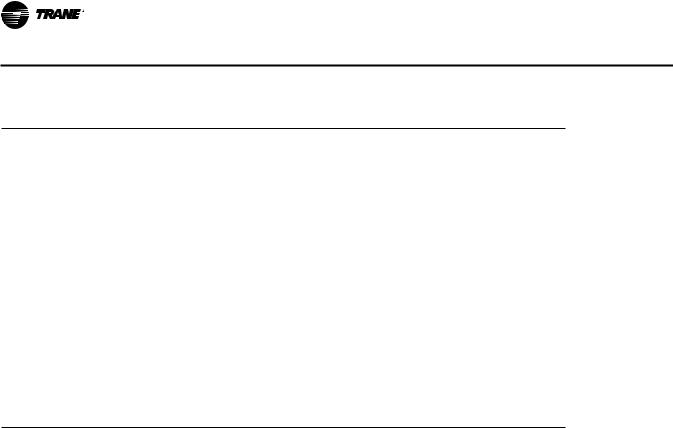
Commonly Used Acronyms
Table 1. Acronyms (continued)
RHI = Remote Human Interface (module) |
UCM = unit control module |
|
|
rpm = revolutions-per-minute |
unocc = unoccupied |
|
|
RT = rooftop unit |
VAV = variable air volume |
|
|
RTM = rooftop module |
VCM = Ventilation Control Module |
|
|
S/A, SA = supply air |
vdc = volts dc |
|
|
SAP = supply air pressure |
vent = ventilation |
|
|
sat = saturated |
vfd = variable frequency drive |
|
|
SCM = Single Circuit Module |
VOM = ventilation override module |
|
|
SF = supply fan |
VSM = variable speed (compressor) module |
|
|
src = source |
VSC = variable speed compressor |
|
|
stg = stage |
VVDA = Variable Volume airflow/Discharge Air temp ctrl |
|
|
stnd = standard |
VVZT = Variable Volume airflow/Zone Temp ctrl |
|
|
stpt, stp = setpoint |
w/, w- = with |
|
|
sw = switch |
w/o, wo- = without |
|
|
sz = single-zone (unit airflow) |
w.c. = water column |
|
|
TCI = Tracer Communications Interface (module) |
wu = warm-up |
|
|
temp = temperature |
XL = across-the-line start |
|
|
RH = right-hand, relative humidity |
|
Notes:
1.Echelon, LON, LONWORKS, LonBuilder, NodeBuilder, LonManager, LonTalk, LonUsers, Neuron, 3120, 3150, the Echelon logo, and the LonUsers logo are trademarks of Echelon Corporation registered in the United States and other countries. LonLink, LonResponse, LonSupport, LonMaker, and LonPoint are trademarks of Echelon Corporation.
2.BACnet® is a registered trademark of the American Society of Heating, Refrigeration and Air-conditioning Engineers Inc. (ASHRAE.)
Glossary of Terms
Carefully review these definitions since they are used throughout this document and the Installation, Operation, Maintenance Guide (IOM). Knowledge of these terms is essential in gaining an understanding of how these units operate.
Active Setpoints. The setpoint which is currently being used by the specified control.
BACnet. An open, device networking communications protocol for controls.This protocol utilizes BACnet and ANSI/ ASHRAE® Standard 135-2004 protocol which provides building owners the capability to connect various types of building control systems or subsystems together
Comparative Enthalpy. An economizer/cooling control strategy which compares return air enthalpy with outdoor enthalpy. If the outdoor enthalpy is significantly less than return enthalpy the economizer will be utilized for cooling.
Compressor Protection Switch. (See Low Pressure Control). A pressure switch installed on the suction line that prevents compressor operation below the switch’s setpoint.The purpose is to prevent no-flow scroll compressor operation.
Comm3/4. ATrane proprietary network communication protocol.
Comm5. Trane's implementation of LonTalk (an open network communication protocol).
Condenser Pressure. The saturated condenser pressure measured on each circuit's condenser section on Evaporative Condenser units. Condenser pressure is converted to Saturated CondenserTemperature for display on the Human Interface.The data from these sensors is used in head pressure control.
Control Band. The range of temperatures, pressures or humidity which would normally be maintained by the various control functions.
Control Point. The value of a setpoint that an algorithm is using at any given time.
6 |
RT-SVP07D-EN |

Commonly Used Acronyms
Deadband. A narrow band of sensor range equally spaced above and below the setpoint that defines a region where the algorithm will be satisfied and the controlled output will be maintained without change.
Dehumidification Override High Zone Temp. The temperature in the critical zone on VAV units where Dehumidification is disabled to prevent over-heating the space due to excess reheat.
Dehumidification Override Low Zone Temp. The temperature in the critical zone on VAV units where Dehumidification is disabled to prevent sub-cooling the space due to insufficient reheat.
Demand Control Ventilation (DCV). An ASHRAE compliant ventilation scheme that varies the Outside Air Damper minimum position or Fresh Air Flow (TRAQs) between minimum and maximum ventilation Setpoints based on CO2 level.
Dry Bulb. An outdoor temperature above which economizing will be disabled (unless comparative enthalpy is the economizer control type being used.)
Economizer Zone Temp Setpoint Suppression. A parameter used for setting the active economizer cooling control point to a value lower than the ZoneTemp Cooling Setpoint to optimize economizer operation.
Emergency Stop. A binary input on the RTM, connected to a field-supplied switch, when set to OPEN causes a unit shutdown with a manual reset diagnostic.
Energy Recovery Wheel. A wheel that rotates through the outdoor and exhaust air streams, transferring energy between the two, to optimize unit efficiency.
Evap Diff. Evaporator Differential is a parameter indicating performance of a refrigeration system. It is calculated by determining the difference between the entering and leaving temperatures of the evaporator. If this value rises too high it may indicate a problem with the system.
External Stop. A binary input on the RTM, connected to a field-supplied switch, when set to OPEN causes a unit stop request.
Fault Detection and Diagnostics. A feature that determines whether the Outside Air damper actuator has failed to control the damper properly, and annunciates specific diagnostics under such conditions.
Hot Gas Bypass. A feature to reduce a refrigeration circuit's cooling capacity by bypassing hot discharge line refrigerant directly to the evaporator coil of the system to more effectively operate in low load conditions.
Humidification Control. During modes of continuous fan operation a relay is energized when the Humidity measured in the controlled space drops below an adjustable Humidification Setpoint.The humidifier device is a user supplied device placed in the supply air stream.
IntelliPak™ I. Units covering the 20 through 130 ton capacity IntelliPak cabinet sizes, and containing the latest control modules and software.
IntelliPak™ II. Units covering the 90 through 150 ton capacity IntelliPak II cabinet sizes, and containing the latest control modules and software.
LonTalk®. An open, device networking communications protocol for controls.This protocol is defined in ANSI approved typical EIA/CEA-709.1-A-1999.
Low Ambient Compressor Lockout. A function which prevents compressor operation at low outdoor ambient temperatures.
Low Vi Compressor Operation. Enhancements to the compressor control will be implemented on units with Low Vi compressors installed, which will insure optimized compressor operation at all times.
Night SetBack (NSB). Applies to the control of the rooftop unit during unoccupied periods. Also refers to the NSB panel, a communicating wall sensor with night setback capability.
Rapid Restart. Certain unit applications require override of the normal unit startup sequence after a power outage. Target cooling requirements are established within a specified time to meet extreme high return air temperatures.
RT-SVP07D-EN |
7 |

Commonly Used Acronyms
Reference Enthalpy. An outdoor enthalpy value, set at the HI, above which economizing will be disabled.
Remote Human Interface. (See Interprocessor Communication Module). A human interface module designed to be mounted remotely from the unit.There are some functional differences between a unit mounted and a remote mounted human interface module.
Reset Amount Maximum. An adjustable parameter on the HI where the maximum amount of reset allowed is defined.
Reset End Temperature. The temperature at which the maximum reset amount will occur.
Reset Start Temperature. The temperature at which reset will begin.
Return Fan Control. . Return Fan Control is a feature which allows units to operate at a higher external or duct system static pressure, or to reduce the load (horsepower requirement) on the supply fan motor.The fan is placed in the return air path.
Return Fan Plenum Pressure. The area between the Exhaust and Return Dampers and the outlet of the Return Fan defines the return plenum.The absolute static pressure measured in this area is the Return Fan Plenum Pressure.
Return Plenum Pressure High Limit. This control feature, available on all return fan options, shuts the supply fan and return fan off if the pressure in the return plenum exceeds a non-adjustable setpoint of 3.5 iwc.
Space Pressure. The pressure in the building as measured by the space pressure transducer, referenced to outside (atmospheric) pressure.
Single Zone Variable Air Volume. The active discharge air setpoint, used for cooling, heating and supply fan speed control, is based on the zone temperature load conditions.
Supply Air Pressure High Limit. A pressure limit to prevent unit casing and/or ductwork over pressurization.
Statitrac™. A control method to maintain proper space pressurization.
Supply Air Pressure. The pressure in inches-water-column (IWC) of the supply duct plenum or outlet as measured by the supply air pressure transducer, referenced to local outside (atmospheric) pressure.
Supply Air Tempering. An active heating mode where the supply air temperature has dropped below a preset value, usually due to cold outside air being brought in to provide building ventilation.
Supply Air Temperature Control Point. The revised value of SATemp Setpoint after supply air temperature reset has been applied.
Supply Air Temperature Reset. A function that shifts the SATemp Setpoint an amount based on the value of another parameter—typically ZoneTemp or Outdoor AirTemp.The purpose of this function is to lower unit capacity to better meet load requirements.
Target Setpoints. An internally calculated control point which is typically derived from other setpoints in combination with specific unit operating conditions.
Variable Speed Compressor. An inverter driven compressor that has the capability to provide continuousincremental cooling capacity control.
UCM Control System
Trane Large Commercial Rooftop Units are controlled by a microelectronic control system that consists of a network of modules and are referred to as Unit Control Modules (UCM).
The unit size, type VVDA (VAV w/ IGV/VFD), SZxx (SZVAV), RRXX (Rapid Restart), CVDA (VAV w/o IGV/VFD), CVZT (CV), VVZT (SZVAV), heating functions, peripheral devices, options, exhaust capabilities, etc. determine the number and type of modules that a particular rooftop unit may employ.
The UCM receives analog or binary inputs, then processes this information and supplies outputs in the form of modulating voltages, contact closures, etc. to control damper actuators, fan motors, compressors, valves, electric heating coils and other electrical devices in the unit to maintain set comfort levels.
8 |
RT-SVP07D-EN |

Commonly Used Acronyms
The UCM provides some equipment protection functions both directly and indirectly, such as duct pressure limits and compressor lockouts.
Listed below are the various modules that may be employed in a UCM control system.
Rooftop Module (1U1 IntelliPak II / 1U48 IntelliPak I)
(standard on all units)The RTM is the central processor of the system. It continuously receives information from the other unit modules, sensors, the remote control panel, and customer supplied relays. It then interprets this information and responds to cooling, heating, and ventilation requests by directing the other modules in the system to energize the proper unit components. It also directly initiates supply and exhaust fan operations, and economizer operation.
Compressor Module (IU3 IntelliPak II / 1U49 IntelliPak I)
(compressor control, head pressure control, evaporative condensing)The SCM/MCM module upon receiving a request for mechanical cooling staging from the RTM, energizes the appropriate compressors. It provides protection of the refrigerant circuit through feedback information it receives from various protection devices. It provides the necessary sensor interface to provide both air-cooled and water-cooled condenser head-pressure control.
Heat Module (1U6 IntelliPak II / 1U50 IntelliPak I)
(staged heat, modulating heat, air-handler chill water valve control)The HEAT module, directs the unit’s heater to stage up, down, or modulate to bring the controlled temperature to within the applicable heating setpoint. Chill water valve control is handled by the modulating output and is coordinated with the heat control to insure proper cooling and heating operation.
Exhaust/Comparative Enthalpy Module (1U5 IntelliPak II / 1U52 IntelliPak I)
(Statitrac building pressure control, comparative enthalpy)The ECEM receives data from the return air humidity sensor, the return air temperature sensor, and the return air space pressure transducer to control the economizer, exhaust fan and the exhaust dampers to maintain set space pressure.
Ventilation Control Module (7U14 IntelliPak II / 3U218 IntelliPak I)
(TRAQ dampers, DCV, outdoor air preheat)The VCM receives data from two velocity pressure sensors associated with front and backTRAQ assemblies to measure fresh air flow entering the unit.These measurements are converted to CFM and added to give total fresh air flow.This value can be used for monitoring purposes, to maintain flow to a minimum fresh air flow Setpoint, or to maintain appropriate CO2 levels in the controlled space using its space CO2 sensor input and the DCV feature.WithoutTRAQ assemblies installed theVCM can use DCV and the CO2 sensor input to control OA Damper minimum position to maintain CO2 levels in the space. A preheat control relay output is also provided on this module to maintain tempered outdoor air during ventilation using the VCM AuxiliaryTemperature input.The preheat unit is usersupplied.
Multi Purpose Module (1U9 IntelliPak II / 1U105 IntelliPak I)
(return fan, energy recovery wheel, evaporative condensing)The MPM supports the function of return plenum pressure control by providing inputs for measuring return plenum pressure, calibrating that reading, and providing an output to control the return fan speed (if variable speed configured) in response to control algorithm requests. EnergyWheel control along with bypass damper control, and interface to the saturated condensing pressure sensors for evaporative condensing head-pressure control.
Modulating Dehumidification Module (1U15 IntelliPak II / 1U107 IntelliPak I)
(dehumidification hot gas reheat)The MDM supports specific control inputs and outputs for modulating dehumidification control including modulating reheat and cooling valve control as well as the reheat pumpout coil relay output.
Generic Building Automation System Module (1U10 GBAS(0-5VDC) / 1U11 GBAS(0-10VDC) IntelliPak II) or (1U51 – GBAS(0-5VDC)/(0-10VDC) IntelliPak I)
(interface to third party BAS controls)The GBAS modules allows a non-Trane building control system to communicate with the unit and accepts external Setpoints in form of analog inputs (0 - 5V or 0 - 10V depending on the module selected) and a binary Input for demand limit. Five (5) binary outputs are available on 0 - 5 V modules. One (1) binary output and four (4) analog outputs are available on the 0 - 10 V modules. Refer to the “Field Installed Control Wiring” section of the
RT-SVP07D-EN |
9 |

Commonly Used Acronyms
Unit Installation, Operation, Maintenance Manual (IOM) for the control wiring to the GBAS module and the various desired Setpoints with the corresponding DC voltage inputs.
Ventilation Override Module (1U8 IntelliPak II / 1U53 IntelliPak I)
(special ventilation unit operation)The VOM module provides the necessary I/O interface to third party customer controls and allows specific override operation of the unit’s air handling functions such as space pressurization, exhaust, purge, unit off, etc.
Variable Speed Module (1U123 IntelliPak I)
(variable speed compressor operation) The VSM module provides the necessary I/O interface to control variable speed compressor drives.
Interprocessor Communications Bridge (1U12 IntelliPak II / 1U55 IntelliPak I)
(communications isolation for remote human interface, external IPC wiring)The IPCB module expands communications from the unit UCM network to a Remote Human Interface Panel. DIP switch settings on the IPCB module for this application should be; Switches 1 and 2 “Off”, Switch 3 “On”.This module is used to isolate the unit communications bus from the outside wiring, and any potential wiring faults that may occur.
BACnet® Communication Interface Module (1U66 IntelliPak II / 1U104
IntelliPak I)
(used on units withTrane ICS or 3rd party Building Automation Systems)The BCI module expands communications from the unit UCM network to aTraneTracer Summit, or a 3rd party building automation system that utilizes BACnet, and allows external Setpoint and configuration adjustment and monitoring of status and diagnostics.
Lontalk® Communication Interface Module (1U7 IntelliPak II / 1U65 IntelliPak I)
(used on units withTrane ICS or 3rd party Building Automation Systems)The LCI module expands communications from the unit UCM network to aTraneTracer Summit, or a 3rd party building automation system that utilizes LonTalk, and allows external Setpoint and configuration adjustment and monitoring of status and diagnostics.
Human Interface Module (Local = 1U2, Remote = 9U13 IntelliPak II) (1U65 IntelliPak I)
(standard on all units)The LHI and RHI (Local and Remote Human Interface) share a similar keypad which is illustrated, see Figure 1. Human Interface Module" on page 11.This device enables the customer, building owner, or contractor, to communicate to the Rooftop unit the necessary parameters for unit operation such as cooling and heating Setpoints, demand limiting, ventilation override modes, etc
The local (unit mounted) Human Interface and the Remote Human Interface Panel functions are identical, except for Service mode which is not available on the Remote Human Interface Panel.
The local HI Module is located in the unit’s main control panel. A small door located in the unit’s control panel door allows access to the HI Module’s keypad and display window.
There is a 2 line by 40 character LCD screen which provides status information for the various unit functions as well as menus used to set or modify the operating parameters.There is a 16 key keypad adjacent to the LCD screen, which allows the operator to scroll through the various menus and make adjustments to the setpoints, etc.
The LCD screen has a backlight that makes the information easier to read.The light will go out if no keys are pressed for 30 minutes. If it goes out, simply press the Status key.
The information displayed in the LCD window will be top-level status information unless the operator initiates other displays.
At power-up, the Human Interface LCD will display one of four initial screens illustrated in the “General Status” section.
10 |
RT-SVP07D-EN |
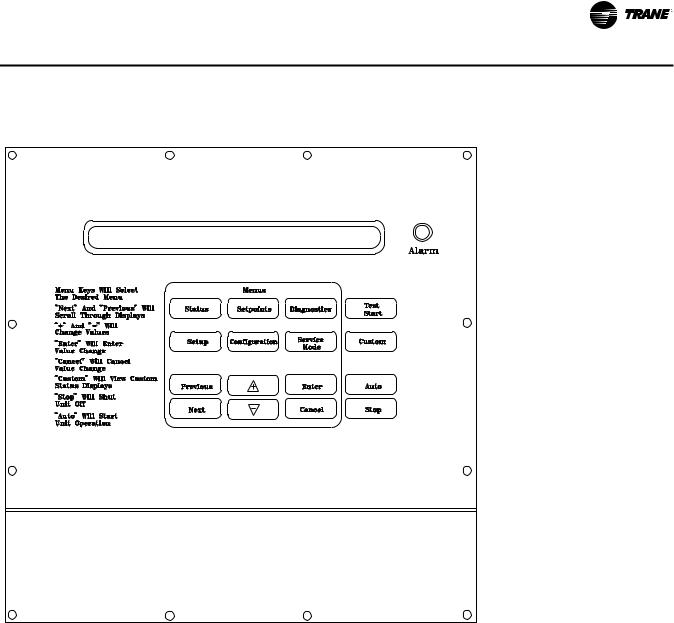
Commonly Used Acronyms
Figure 1. Human Interface Module
Menu Keys
The six main menu keys illustrated in Figure 2. Human Interface Keypad, (Status, Setpoints, Setup, Configuration, Diagnostics, and Service Mode) are used to bring up the various interactive menus where the user inputs and accesses unit operating data. Pressing these keys will display the initial screen for the menu designated by the key’s name.The following information describes the keys and their functions when viewing the various menus.
Note:
1.If no key is pressed for 30 minutes while the LCD is displaying a menu screen, it will revert back to the unit operating status screen.
Status Key
Pressing the Status key causes the LCD to display the operating status screen; i.e. “On”, “Unit Stop”, “External Stop”, “Emergency Stop”, “Service Mode”.Pressing the Next key allows the operator to scroll through the screens which provide information such as air and refrigerant temperatures, humidity levels, fan operation, compressor operation, heater operation, economizer positioning, exhaust operation, as well as heating, cooling, and compressor lockout setpoints. Pressing the Status key while viewing any of the data screens will cause the LCD to go back to the operating status screen.
RT-SVP07D-EN |
11 |

Commonly Used Acronyms
Setpoints Key
Pressing the Setpoints key will cause the LCD screen to display the first of the setpoint screens where the operator will designate default temperature and pressure setpoints. While scrolling through the setpoint screens, pressing this key again will cause the LCD to display the first setpoint screen.
Diagnostics Key
Pressing the Diagnostics key at any time will allow the operator to view any active unit diagnostics, or 20 of the most recently logged unit diagnostics.The LCD screen will display one of the diagnostic screens (depending on which diagnostic, if any, is present). If no key is pressed for 30 minutes while the screen is displaying diagnostic information, it will revert back to the operating status display.
Configuration Key
Pressing the Configuration key will cause the LCD screen to display the first of the configuration screens where the operator will designate unit configuration data such as unit type, capacity, system control, etc.
This information was programmed at the factory. Pressing the configuration key at any level in the configuration menu will display the first configuration screen.
Note:
1.This key should be used if the unit’s configuration data is lost or new options are added in the field, and to view current configuration.
2.The Stop key must be pressed prior to making any changes under the Configuration menu.
Setup Key
Pressing the Setup key will cause the LCD screen to display screens where the operator will designate various operating parameters such as temperature and pressure ranges, limits, percentages, setpoint source selections, and sensor input definitions for the control of the rooftop unit’s various operating modes. Pressing the Setup key at any level in the setup menu will display the first setup screen.
Service Mode Key
Pressing the Service Mode key causes the LCD to display the first of the service test mode screens showing various unit components which may be turned on or off for the particular test being performed. Once the status of these components is designated, the LCD will display screens that allow the operator to designate theTEST START time delay for each test.
Data Manipulation Keys
The six data manipulation keys illustrated in Figure 2. Human Interface Keypad" on page 14, (Enter, Cancel, + (Plus), - (Minus), Previous, and Next are used to modify the data within the screens (change values, move the cursor, confirm choices)
Enter Key
The Enter key will confirm the new values that were designated by pressing the + (Plus) or - (Minus) keys at all edit points. When viewing status and diagnostics screens, it has no function.
Cancel Key
After changing data, at an editable screen, but before confirming it with the Enter key, pressing the Cancel key will return the data to its previous value.This key shall also function to clear active diagnostics.
+ (Plus) Key
When viewing a setpoint screen, this key will increase the value of the displayed item per the units selected.When working with a status menu, it will add the current status display to the CUSTOM MENU. When viewing setup, or service test screens, it will proceed forward though all the selections of that menu item, increase setpoints, toggle choices OFF to ON, DISABLED to ENABLED.
12 |
RT-SVP07D-EN |

Unit Operation Keys
- (Minus) Key
When viewing a setpoint screen, this key will decrease the value of the displayed item per the units selected. When working with a CUSTOM MENU, it will delete the current selected display. When viewing setup, or service test screens, it will proceed backwards though all the selections of that menu item, decrease setpoints, toggle choices ON to OFF, ENABLED to DISABLED.
Next Key
Pressing the Next key causes the LCD to scroll forward through the various displays for each menu. At displays with multiple edit points it moves the cursor forward from one edit point to another.
Previous Key
Pressing the Previous key causes the LCD to scroll backward through the various displays for each menu. At displays with multiple edit points, it moves the cursor backward from one edit point to another.
Unit Operation Keys
The four unit operation keys (Auto, Stop,Test Start, Custom) are used to control and monitor the unit in normal operating mode, and also to initiate an active unit service test event.
Auto Key
Pressing the Auto key at any time will cause the display to go to the top level status display and, if the unit is shutdown, will cause the unit to begin operation in the appropriate mode no matter what level in the menu structure is currently being displayed. If the current display is an editable display, the Auto key will confirm the desired edit point similar to the Enter key.
Stop Key
Pressing the Stop key will cause the unit to transition to the stop state. If the current display is editable, pressing the Stop key will cancel the desired edit similar to the Cancel key. Prior to making any changes to the configuration menu screens, the Stop key must be pressed.
Test Start Key (Service Test Mode Start)
Pressing theTest Start key while viewing any screen in the Service Mode Menu will start the service test. Pressing this key while displaying any screen other than the Service Mode Menu will not start the service test, and has no other function.
Custom Key
Pressing the Custom key will change the display to the Custom Menu.This menu is simply a status menu that contains screens that the user monitors most frequently.The custom menu can only contain five status screens.To create the custom menu, press the Status key, followed by the Next key (this brings up the initial status screen). If you want to add this screen to the custom menu, press the + (Plus) key, if not, press the Next key again until a status screen appears that you would like to add to the custom menu. Pressing the + (Plus) key while viewing any of the various status screens will add that screen to the custom menu. Once the custom menu is programmed it can be accessed by pressing the Custom key.To remove a status screen from the custom menu, press the Custom key, then press the Next key until the status screen that you want to remove appears, then press the - (Minus) key.
General Status Display
Anytime the rooftop unit is powered up, or the Status,Auto, or Stop keys are pressed, the unit mounted Human Interface will display one of the following general status display screens.The operator will then be able to enter keystrokes which will allow him to navigate through a set of menus and submenus in order to provide/access various monitoring, setup,
RT-SVP07D-EN |
13 |
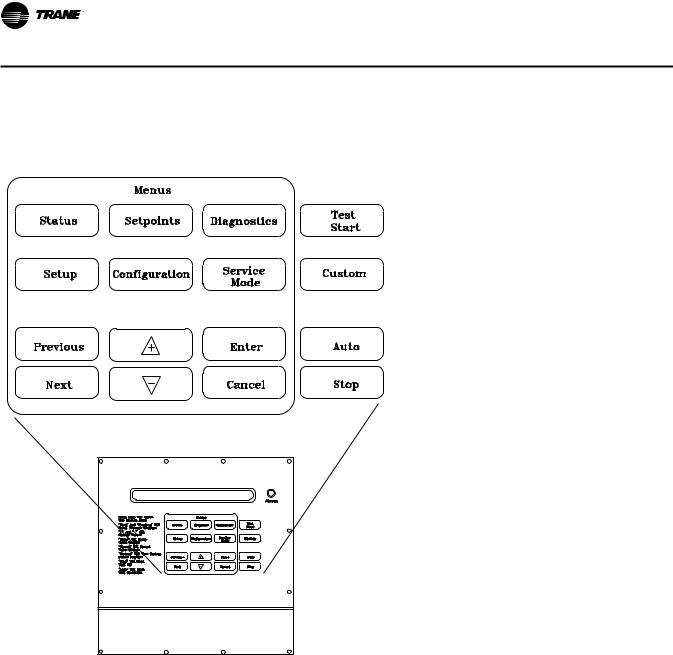
General Status Display
and configuration information.The Human Interface will not display screens or parts of screens for which the unit is not configured.
Figure 2. Human Interface Keypad
14 |
RT-SVP07D-EN |
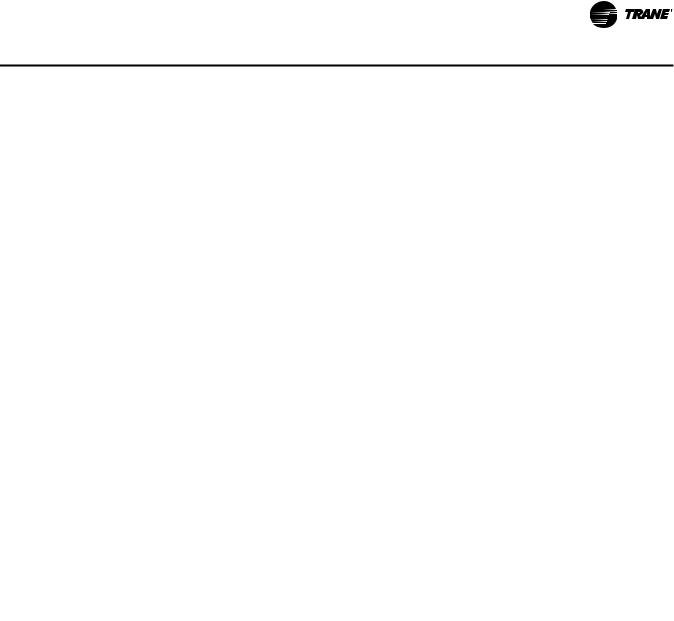
General Status Display
Unit “Off” or “Stopped”
If at power up the unit is not running, the following display will appear on the Human Interface LCD screen. When this screen is being displayed, the only functional keys are the six menu keys (Status, Setpoints, Diagnostics, Setup,
Configuration, and Service Mode), the Auto key, the Custom key, and the Stop key.
Stop by Network |
Supply Fan ON |
|
Initializing |
|
Diagnostics |
|
|
|
Top Left Field: |
Top Right Field: |
|
Unit Off |
Supply Fan OFF |
|
Unit Stopped |
Supply Fan ON |
|
External Stop |
|
|
Emergency Stop |
|
|
Stop by Network |
|
|
Unit Starting
Service Mode Off
Used With: Top Status Display
(Shown when unit is off or stopped)
Possible Values:
[see field descriptions at left]
Bottom Left Field: Bottom Right Field:
(blank) |
(blank) |
Shutdown |
(Diagnostics) |
Initializing |
|
Freeze Avoidance |
|
Active |
|
Unit “On”
If the unit has entered an operating state (running), the following display will appear on the Human Interface LCD screen. When this screen is being displayed, the only functional keys are the six menu keys (Status, Setpoints, Diagnostics,
Setup, Configuration, and Service Mode), the Auto key, the Custom key, and the Stop key.
VVDA OA Flow 380.0 CCFM |
Supply Fan ON |
||
Occupied |
Cool |
2 |
Diagnostics |
|
|
|
|
Top Left Field: |
Top Middle Field: |
Top Right Field: |
|
CVZT |
(blank) |
|
Supply Fan ON |
VVDA |
OA Flow 0 to 500 |
Supply Fan OFF |
|
CVDA |
CCFM |
|
|
VVZT |
Freeze Avoidance |
|
|
BottomLeftField: BottomMiddleField: BottomRightField: |
|||
(blank) |
(blank) |
|
(blank) |
Occupied |
Heat 1 to 6 |
Diagnostics |
|
Unoccupied |
Cool 1 to 4 |
|
|
MorningWU |
OA Dmpr 0 to 100 % |
||
DaytimeWU |
Dehumid |
|
|
Standby |
Purge |
|
|
Shutdown |
Humidify |
|
|
Occupied TOV |
SA Fan 0 to 100% |
|
|
Initializing
Tempering
Rapid Restart
Used With: Top Status Display (Shown when unit is on)
Possible Values:
[see field descriptions at left]
RT-SVP07D-EN |
15 |
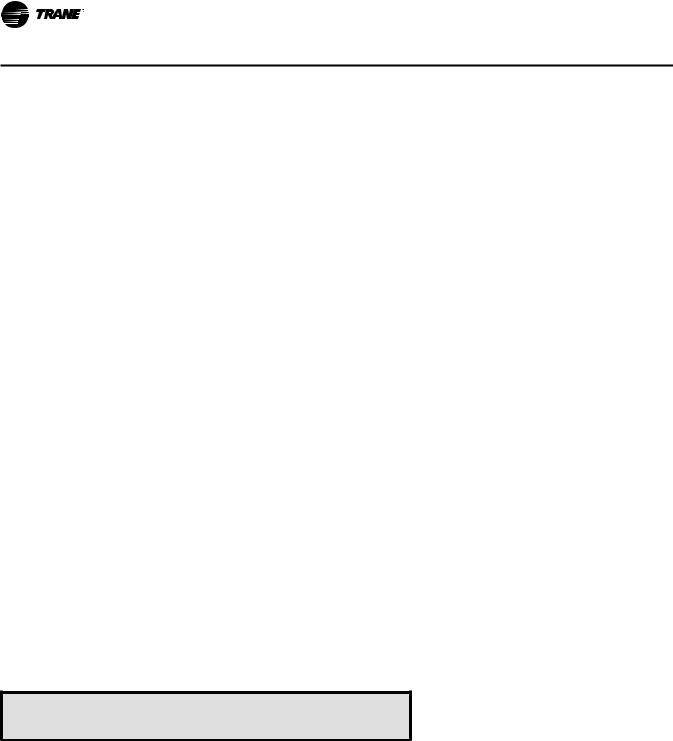
General Status Display
“Emergency Override” Active
If the unit has entered an Emergency Override mode of operation, one of the following displays will appear on the Human Interface LCD screen.
Ventilation Override Mode |
|
Used With: LCI or BCI Options |
PRESSURIZE |
Diagnostics |
Top Left Field: |
|
|
Top Right Field: (blank) |
|
|
|
|
|
Bottom Left Field: |
|
|
PRESSUREIZE |
|
|
DEPRESSURIZE |
|
|
PURGE |
|
|
SHUTDOWN |
|
|
FIRE |
|
|
Bottom Right Field: |
|
|
Diagnostics (Trouble Indicator) |
|
|
(blank) |
“VOM” Active
If at power up the unit is running and has entered a Ventilation Override mode of operation, the following display will appear on the Human Interface LCD screen.
Ventilation Override Mode |
A |
|
Diagnostics |
|
|
Used With: VOM Option
Possible Values:
Top Right Field: A, B, C, D, E, OFF
Bottom Left Field:
(blank)
Bottom Right Field:
Diagnostics (Trouble Indicator) (blank)
“No Configuration” Condition
If at power up the unit has not been programmed with the necessary configuration data for normal unit operation, the following display will appear on the Human Interface LCD screen.When this screen is being displayed, the only functional key is the Configuration key.
Note: This screen will only appear when the RTM has been field replaced. Refer to the Configuration Menu section.
NO CONFIGURATION PRESENT PRESS CONFIGURATION KEY
Used With: All Units
16 |
RT-SVP07D-EN |

General Status Display
Factory Presets
The UCM controlled unit has many operating functions which are preset at the factory, but may be modified to meet the unique requirements of each job.The following list in Table 2, identifies each of the unit’s adjustable functions and the value assigned to it. If these factory presets match the application’s requirements, simply press theAuto key at the Human Interface module to begin unit operation (after completing the Pre-Start and Start-Up procedures in the Installation, Operation, and Maintenance manual). If the application requires different settings, turn to the listed page beside the function, press the designated function menu key, then press and hold the Next or Previous key until its screen appears on the LCD. Once the proper screen appears, simply follow the programming instructions given below the applicable screen in this manual.
Note: Listed items availability is dependent on unit configuration.)
Table 2. Factory Presets List (Note: Listed Items availability is dependent on unit configuration.
|
|
|
To adjust |
Adjustable Function |
Factory Preset |
Changed To |
press... |
General Function |
|
|
|
Unit Address (Comm3/Comm4only) |
1 |
___________ |
Setup |
System Mode |
Auto |
___________ |
Setup |
Supply Fan Mode |
Auto |
___________ |
Setup |
Unit Start Delay |
0 |
___________ |
Setup |
Single Zone VAV Econ Control |
Enabled |
___________ |
Setup |
Single Zone VAV Heat Control |
Disabled |
___________ |
Setup |
Daytime Warm-up |
Disabled |
___________ |
Setup |
Morning Warm-up |
Enabled |
___________ |
Setup |
Morning Warm-up type |
Cycling |
___________ |
Setup |
Supply Air Tempering |
Disabled |
___________ |
Setup |
Unoccupied Mechanical Cooling |
Enable |
___________ |
Setup |
Unoccupied Heating |
Enable |
___________ |
Setup |
Unoccupied Mechanical Cooling |
Enable |
___________ |
Setup |
Unoccupied Heating |
Enable |
___________ |
Setup |
Occupied Dehumidification |
Enable |
___________ |
Setup |
Unoccupied Dehumidification |
Enable |
___________ |
Setup |
Occupied Humidification |
Disable |
___________ |
Setup |
Unoccupied Humidification |
Disable |
___________ |
Setup |
Rapid Restart Economizer Control |
Disable |
___________ |
Setup |
VCM Preheat Output |
Disable |
___________ |
Setup |
Demand Limit Definition - Cooling |
None |
___________ |
Setup |
Demand Limit Definition - Heating |
None |
___________ |
Setup |
Compressor Lead/Lag |
Enable |
___________ |
Setup |
Evap Temperature Limit |
35 F |
___________ |
Setup |
Coil Frost Cutout Temp |
30 F |
___________ |
Setup |
Isolation Damper Interlock |
Disable |
___________ |
Setup |
Information Format |
|
|
|
Display Text |
English |
___________ |
Setup |
Display Units |
English |
___________ |
Setup |
VAV Control |
|
|
|
SA Temp Reset Cool |
None |
___________ |
Setup |
RT-SVP07D-EN |
17 |

General Status Display
Table 2. Factory Presets List (continued)(Note: Listed Items availability is dependent on unit configuration.
|
|
|
To adjust |
Adjustable Function |
Factory Preset |
Changed To |
press... |
Reset Cool Start Temp (Zone/OA) |
(72/90) |
___________ |
Setup |
Reset Cool End Temp (Zone/OA) |
(69/70) |
___________ |
Setup |
Reset Cool Max Amount |
5 |
___________ |
Setup |
SA Temp Reset Heat |
None |
___________ |
Setup |
Reset Heat Start Temp (Zone/OA) |
(65/10) |
___________ |
Setup |
Reset Heat End Temp (Zone/OA) |
(68/60) |
___________ |
Setup |
Reset Heat Max Amount |
10 |
___________ |
Setup |
VAV Box Stroke Time |
6 Min |
___________ |
Setup |
Max Occ. IGV/VFD Command |
100 % |
___________ |
Setup |
Economizer Control |
|
|
|
Economizer Control Enable Type |
Drybulb |
___________ |
Setup |
Unoccupied Economizer |
Enable |
___________ |
Setup |
Head Pressure Control |
|
|
|
Sump Drain Relay Control (on power loss) |
Drain |
___________ |
Setup |
Sump Purge Interval Time |
Disabled |
___________ |
Setup |
Sump Purge Duration Time (IPak-I/IPak-II)(a) |
(120/60 sec.) |
___________ |
Setup |
Sump Water Heater Setpoint |
38 F |
___________ |
Setup |
Low Limit (Air-cooled/Water-cooled)(a) |
(80/70 deg F) |
___________ |
Setup |
Upper Limit |
120 deg F |
___________ |
Setup |
Temporary low limit suppression |
20 deg F |
___________ |
Setup |
Efficiency check point |
105 deg F |
___________ |
Setup |
Low amb. control point (Air-cooled/Water-cooled)(a) |
(90/80 deg F) |
___________ |
Setup |
Alternate Refrigerant Type(a) |
Disabled |
___________ |
Setup |
Sensor Source Selection |
|
|
|
Daytime Warm-Up |
RTM Zone Temp |
___________ |
Setup |
Occupied Zone Control |
RTM Zone Temp |
___________ |
Setup |
Unoccupied Zone Control |
RTM Zone Temp |
___________ |
Setup |
Morning Warm-Up |
RTM Zone Temp |
___________ |
Setup |
Space Humidity Control |
RTM Space Humidity |
___________ |
Setup |
Dehumid OVRD Zone Temp |
RTM Zone Temp |
___________ |
Setup |
Zone Reset Function |
RTM Zone Temp |
___________ |
Setup |
Rapid Restart Function |
ECEM Return Temp |
___________ |
Setup |
Monitor |
RTM Zone Temp |
___________ |
Setup |
Outside Air Ventilation |
|
|
|
Demand Control Ventilation |
Disable |
___________ |
Setup |
Active/Passive DCV Control |
Passive |
___________ |
Setup |
OA Flow Compensation |
Enabled |
___________ |
Setup |
OA Flow C02 Reset (IPak-INon-DCV) |
Disabled |
___________ |
Setup |
CO2 Start (IPak-I Non-DCV) |
800 |
___________ |
Setup |
CO2 Max (IPak-I Non-DCV) |
1000 |
___________ |
Setup |
18 |
RT-SVP07D-EN |

General Status Display
Table 2. Factory Presets List (continued)(Note: Listed Items availability is dependent on unit configuration.
|
|
|
To adjust |
Adjustable Function |
Factory Preset |
Changed To |
press... |
OA Flow Calibration Gain (Left) |
1.0 |
___________ |
Setup |
OA Flow Calibration Offset (Left) |
0 CFM |
___________ |
Setup |
OA Flow Calibration Gain (Right) |
1.0 |
___________ |
Setup |
OA Flow Calibration Offset (Right) |
0 CFM |
___________ |
Setup |
OA Normalization |
100 CCFM |
___________ |
Setup |
OA Flow Calibration Data - Altitude: |
0 Ft |
___________ |
Setup |
RTM Alarm Output Definition |
Any Active Diagnostic |
___________ |
Setup |
GBAS Input/Output Definitions |
|
|
|
GBAS (0-5) Analog Input 1 Definitions |
Not Assigned |
___________ |
Setup |
GBAS (0-5) Analog Input 2 Definitions |
Not Assigned |
___________ |
Setup |
GBAS (0-5) Analog Input 3 Definitions |
Not Assigned |
___________ |
Setup |
GBAS (0-5) Analog Input 4 Definitions |
Not Assigned |
___________ |
Setup |
GBAS (0-5) Output 1 Definitions |
Not Assigned |
___________ |
Setup |
GBAS (0-5) Output 2 Definitions |
Not Assigned |
___________ |
Setup |
GBAS (0-5) Output 3 Definitions |
Not Assigned |
___________ |
Setup |
GBAS (0-5) Output 4 Definitions |
Not Assigned |
___________ |
Setup |
GBAS (0-5) Output 5 Definitions |
Not Assigned |
___________ |
Setup |
GBAS (0-10) Analog Input 1 Definitions |
Not Assigned |
___________ |
Setup |
GBAS (0-10) Analog Input 2 Definitions |
Not Assigned |
___________ |
Setup |
GBAS (0-10) Analog Input 3 Definitions |
Not Assigned |
___________ |
Setup |
GBAS (0-10) Analog Input 4 Definitions |
Not Assigned |
___________ |
Setup |
GBAS (0-10) Output 1 Definitions |
Not Assigned |
___________ |
Setup |
GBAS (0-10) Output 2 Definitions |
Not Assigned |
___________ |
Setup |
GBAS (0-10) Output 3 Definitions |
Not Assigned |
___________ |
Setup |
GBAS (0-10) Output 4 Definitions |
Not Assigned |
___________ |
Setup |
GBAS (0-10) Output 5 Definitions |
Not Assigned |
___________ |
Setup |
Ventilation Override Definition |
See Definitions |
___________ |
Setup |
Temperature Input Offset for... |
|
|
|
RTM Zone Temperature |
0 deg F |
___________ |
Setup |
RTM Aux Temperature |
0 deg F |
___________ |
Setup |
Outdoor Air Temperature |
0 deg F |
___________ |
Setup |
Heat Aux Temperature |
0 deg F |
___________ |
Setup |
Return Air Temperature |
0 deg F |
___________ |
Setup |
Device Characteristics… |
|
|
|
Outside Air Damper (if equipped) |
|
|
|
Actuator Setup |
Direct |
___________ |
Setup |
Max Stroke Time |
30 sec |
___________ |
Setup |
Max Voltage |
10 VDC |
___________ |
Setup |
RT-SVP07D-EN |
19 |

General Status Display
Table 2. Factory Presets List (continued)(Note: Listed Items availability is dependent on unit configuration.
|
|
|
To adjust |
Adjustable Function |
Factory Preset |
Changed To |
press... |
Min Voltage |
2 VDC |
___________ |
Setup |
Supply Fan IGV/VFD (if equipped) |
|
|
|
Actuator Setup |
Direct |
___________ |
Setup |
Max Stroke Time |
30/0 sec |
___________ |
Setup |
Max Voltage |
10 VDC |
___________ |
Setup |
Min Voltage |
2 VDC |
___________ |
Setup |
Return Fan VFD (if equipped) |
|
|
|
Actuator Setup |
Direct |
___________ |
Setup |
Max Stroke Time |
60/0 sec |
___________ |
Setup |
Max Voltage |
10 VDC |
___________ |
Setup |
Min Voltage |
2 VDC |
___________ |
Setup |
Exhaust Damper/VFD (if equipped) |
|
|
|
Actuator Setup |
Direct |
___________ |
Setup |
Max Stroke Time |
60 sec |
___________ |
Setup |
Max Voltage |
10 VDC |
___________ |
Setup |
Min Voltage |
0 VDC |
___________ |
Setup |
Hydronic Heat (if equipped) |
|
|
|
Actuator Setup |
Direct |
___________ |
Setup |
Max Stroke Time |
60 sec |
___________ |
Setup |
Max Voltage |
10 VDC |
___________ |
Setup |
Min Voltage |
2 VDC |
___________ |
Setup |
Low Ambient Damper Ckt-1 (if equipped) |
|
|
|
Actuator Setup |
Direct |
___________ |
Setup |
Max Stroke Time |
60 sec |
___________ |
Setup |
Max Voltage |
10 VDC |
___________ |
Setup |
Min Voltage |
2 VDC |
___________ |
Setup |
Low Ambient Damper Ckt-2 (if equipped) |
|
|
|
Actuator Setup |
Direct |
___________ |
Setup |
Max Stroke Time |
60 sec |
___________ |
Setup |
Max Voltage |
10 VDC |
___________ |
Setup |
Min Voltage |
2 VDC |
___________ |
Setup |
Cond Fan VFD Ckt -1(if equipped) |
|
|
|
Actuator Setup |
Direct |
___________ |
Setup |
Max Stroke Time |
60 sec |
___________ |
Setup |
Max Voltage |
10 VDC |
___________ |
Setup |
Min Voltage |
0 VDC |
___________ |
Setup |
20 |
RT-SVP07D-EN |

General Status Display
Table 2. Factory Presets List (continued)(Note: Listed Items availability is dependent on unit configuration.
|
|
|
To adjust |
Adjustable Function |
Factory Preset |
Changed To |
press... |
Cond Fan VFD Ckt-2 (if equipped) |
|
|
|
Actuator Setup |
Direct |
___________ |
Setup |
Max Stroke Time |
60 sec |
___________ |
Setup |
Max Voltage |
10 VDC |
___________ |
Setup |
Min Voltage |
0 VDC |
___________ |
Setup |
Modulating Gas Heat Actuator (if equipped) |
|
|
|
Actuator Setup (Ipak-I/Ipak-II)(a) |
(Direct/Reverse) |
___________ |
Setup |
Max Stroke Time |
90 sec |
___________ |
Setup |
Max Voltage |
10 VDC |
___________ |
Setup |
Min Voltage (Ipak-I/Ipac-II)(a) |
(5 VDC/2 VDC) |
___________ |
Setup |
Outdoor Air Bypass Damper (if equipped) |
|
|
|
Actuator Setup |
Direct |
___________ |
Setup |
Max Stroke Time |
60 sec |
___________ |
Setup |
Max Voltage |
10 VDC |
___________ |
Setup |
Min Voltage |
2 VDC |
___________ |
Setup |
Exhaust Bypass Damper (if equipped) |
|
|
|
Actuator Setup |
Direct |
___________ |
Setup |
Max Stroke Time |
60 sec |
___________ |
Setup |
Max Voltage |
10 VDC |
___________ |
Setup |
Min Voltage |
2 VDC |
___________ |
Setup |
Variable Speed Comp (if equipped) |
|
|
|
Actuator Setup |
Direct |
___________ |
Setup |
Max Stroke Time |
30 sec |
___________ |
Setup |
Max Voltage |
10 VDC |
___________ |
Setup |
Min Voltage |
0 VDC |
___________ |
Setup |
Control Algorithm Tuning Parameters |
|
|
|
(Partial)(a) |
|
|
|
VAV Cooling Control Gains |
|
|
|
Proportional (w-VSC / wo-VSC) |
(2.0%/F/3.3%/F) |
___________ |
Setup |
Reset Time (w-VSC/wo-VSC) |
(100 Sec/50 Sec) |
___________ |
Setup |
Zone Control Occupied Heating Proportional Gain |
|
|
|
IPak I Gas |
30.0 deg F |
___________ |
Setup |
IPak I Electric |
45.0 deg F |
___________ |
Setup |
IPak II Gas |
30.0 deg F |
___________ |
Setup |
IPak II Electric-90 kw |
45.0 deg F |
___________ |
Setup |
IPak II Electric -140 kw |
60.0 deg F |
___________ |
Setup |
IPak II Electric-265 kw |
75.0 deg F |
___________ |
Setup |
IPak II Electric-300 kw |
75.0 deg F |
___________ |
Setup |
RT-SVP07D-EN |
21 |

General Status Display
Table 2. Factory Presets List (continued)(Note: Listed Items availability is dependent on unit configuration.
|
|
|
|
To adjust |
Adjustable Function |
Factory Preset |
Changed To |
press... |
|
CV Air Economizer Control Gains |
|
|
|
|
Proportional |
10.0 % F |
___________ |
Setup |
|
Reset Time |
DISABLE |
___________ |
Setup |
|
Rate Time |
0 Sec |
___________ |
Setup |
|
Bias |
0 deg F |
___________ |
Setup |
|
SZVAV Cooling Control Gains |
|
|
|
|
Proportional |
6.0 % F |
___________ |
Setup |
|
Reset Time |
1200 |
Sec |
___________ |
Setup |
Rate Time |
0 Sec |
___________ |
Setup |
|
Bias |
0 deg F |
___________ |
Setup |
|
Zone Control Modulating Heat Gains |
|
|
|
|
Proportional |
10.0 % F |
___________ |
Setup |
|
Reset Time |
DISABLE |
___________ |
Setup |
|
Rate Time |
0 Sec |
___________ |
Setup |
|
Bias |
0 deg F |
___________ |
Setup |
|
SZVAV Heating Control Gains |
|
|
|
|
Proportional |
8.0% F |
___________ |
Setup |
|
Reset Time |
1200 |
Sec |
___________ |
Setup |
Rate Time |
0 Sec |
___________ |
Setup |
|
Bias |
0 deg F |
___________ |
Setup |
|
Rapid DX Interstage Timing |
30 Sec |
___________ |
Setup |
|
Default Setpoints |
|
|
|
|
Supply Air Cooling (VAV/SZVAV)(a) |
(55 F/50 F) |
___________ |
Setpoints |
|
Supply Air Heating (VAV/SZVAV)(a) |
(100 F/105 F) |
___________ |
Setpoints |
|
SA Cool Deadband |
8.0 F |
___________ |
Setpoints |
|
SA Heat Deadband |
4.0 F |
___________ |
Setpoints |
|
DWU Initiate |
67 |
F |
___________ |
Setpoints |
DWU Terminate |
71 |
F |
___________ |
Setpoints |
Occupied Zone Cooling |
74 |
F |
___________ |
Setpoints |
Occupied Zone Heating |
71 |
F |
___________ |
Setpoints |
Zone Derived Setpoint |
4 F |
___________ |
Setpoints |
|
Unoccupied Zone Cooling |
85 |
F |
___________ |
Setpoints |
Unoccupied Zone Heating |
60 |
F |
___________ |
Setpoints |
Unoccupied Zone MWU |
72 |
F |
___________ |
Setpoints |
Rapid Restart Critical Temp(a) |
90 |
F |
___________ |
Setpoints |
Occ Dehumidification |
60% |
___________ |
Setpoints |
|
Occ Dehumid Hysteresis Offset |
5% |
___________ |
Setpoints |
|
Unocc Dehumidification |
60% |
___________ |
Setpoints |
|
Unocc Dehumid Hysteresis Offset |
5% |
___________ |
Setpoints |
|
Supply Air Reheat Setpoint |
70 |
F |
___________ |
Setpoints |
Supply Air Reheat Deadband |
4 F |
___________ |
Setpoints |
|
Maximum Reheat Valve Limit |
85% |
___________ |
Setpoints |
|
Dehumid Ovrd High Zone Temp |
75 |
F |
___________ |
Setpoints |
22 |
RT-SVP07D-EN |

General Status Display
Table 2. Factory Presets List (continued)(Note: Listed Items availability is dependent on unit configuration.
|
|
|
To adjust |
Adjustable Function |
Factory Preset |
Changed To |
press... |
Dehumid Ovrd Low Zone Temp |
68 F |
___________ |
Setpoints |
Cond Coil Purge Interval |
90 Min |
___________ |
Setpoints |
Occ Humidification |
30% |
___________ |
Setpoints |
Occ Humidification Hysteresis Offset |
5% |
___________ |
Setpoints |
Unocc Humidification |
30% |
___________ |
Setpoints |
Unocc Humidification Hysteresis Offset |
5% |
___________ |
Setpoints |
Economizer Cooling Setpoint Suppression (CV) |
3 F |
___________ |
Setpoints |
Reference Enthalpy |
25 BTU/LB |
___________ |
Setpoints |
Economizer Drybulb Enable Stpt |
75 F |
___________ |
Setpoints |
Supply Air Low Limit |
50 F |
___________ |
Setpoints |
VCM Preheat Actuate Temp |
35 F |
___________ |
Setpoints |
Design Min CO2 (DCV) |
1000 PPM |
___________ |
Setpoints |
DCV Min CO2 |
800 PPM |
___________ |
Setpoints |
Design Min OA Flow (DCV) |
220 CCFM |
___________ |
Setpoints |
DCV Min OA Flow |
67 CCFM |
___________ |
Setpoints |
DCV Min OA Flow Deadband |
5 CCFM |
___________ |
Setpoints |
Min OA Flow w\ VCM |
Set per unit size |
___________ |
Setpoints |
Min OA Flow Deadband |
Set per unit size |
___________ |
Setpoints |
Design Min OA Damper Position (DCV) |
15% |
___________ |
Setpoints |
DCV Min OA Damper Position |
5% |
___________ |
Setpoints |
OA Damper Min Position (non-DCV) |
15% |
___________ |
Setpoints |
OAD Min Position w/IGV/VFD at 0% |
25% |
___________ |
Setpoints |
OAD Min Position w/IGV/VFD at 50% |
20% |
___________ |
Setpoints |
OAD Min Position w/IGV/VFD at 100% |
15% |
___________ |
Setpoints |
OAD Min Position (Default) |
15% |
___________ |
Setpoints |
Supply Air Pressure |
2.0 IWC |
___________ |
Setpoints |
Supply Air Pressure High Limit |
4.0 IWC |
___________ |
Setpoints |
Supply Air Pressure Deadband |
0.5 IWC |
___________ |
Setpoints |
Max Return Plenum Pressure |
0.8 IWC |
___________ |
Setpoints |
Return Plenum Pressure Deadband |
0.1 IWC |
___________ |
Setpoints |
Space Pressure - Setpoint |
0.08 IWC |
___________ |
Setpoints |
Space Pressure - Deadband |
.04 IWC |
___________ |
Setpoints |
Space Pressure Low Limit |
-0.2 IWC |
___________ |
Setpoints |
Exhaust Enable Point |
25% |
___________ |
Setpoints |
Exhaust Inhibit Point |
DISABLE |
___________ |
Setpoints |
Low Ambient Comp. Lockout (Standard Units) |
50 F |
___________ |
Setpoints |
Low Ambient Comp. Lockout (Low Ambient Units) |
0 F |
___________ |
Setpoints |
Standby Freeze Avoidance |
0% |
___________ |
Setpoints |
Recovery Frost Avoidance Setpoint |
27 F |
___________ |
Setpoints |
Setpoint Source Selection For... |
|
|
|
Supply Air Temp Cooling |
Hi Default |
___________ |
Setpoints |
Supply Air Temp Heating |
Hi Default |
___________ |
Setpoints |
Occupied Zone Cooling |
Hi Default |
___________ |
Setpoints |
RT-SVP07D-EN |
23 |
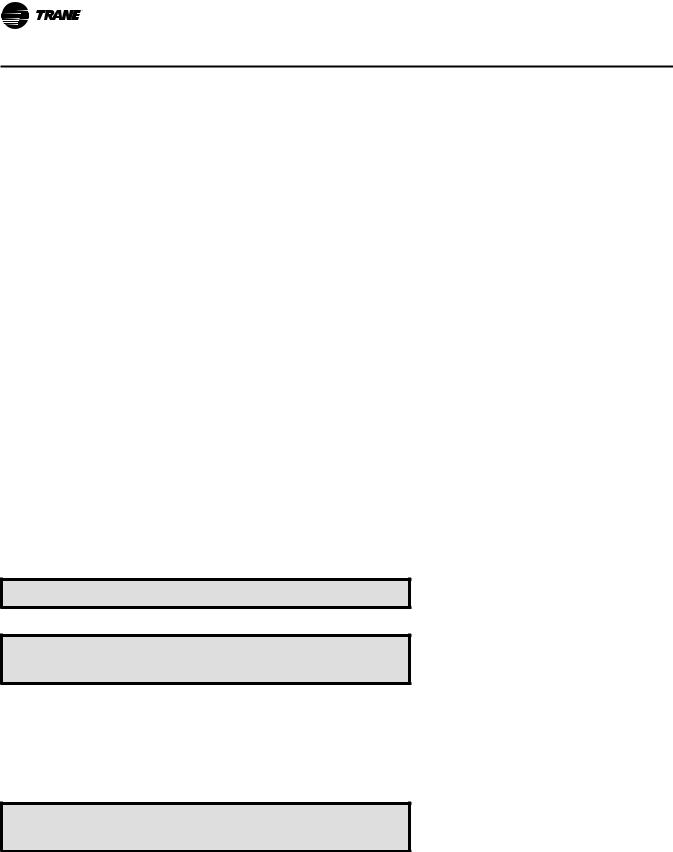
General Status Display
Table 2. Factory Presets List (continued)(Note: Listed Items availability is dependent on unit configuration.
|
|
|
To adjust |
Adjustable Function |
Factory Preset |
Changed To |
press... |
Occupied Zone Heating |
Hi Default |
___________ |
Setpoints |
Unoccupied Zone Cooling |
Hi Default |
___________ |
Setpoints |
Unoccupied Zone Heating |
Hi Default |
___________ |
Setpoints |
Morning Warm-Up |
Hi Default |
___________ |
Setpoints |
Economizer Dry Bulb Enable |
Hi Default |
___________ |
Setpoints |
Outside Damper Minimum Position |
Hi Default |
___________ |
Setpoints |
Occupied Dehumidification |
Hi Default |
___________ |
Setpoints |
Unoccupied Dehumidification |
Hi Default |
___________ |
Setpoints |
Supply Air Reheat |
Hi Default |
___________ |
Setpoints |
Occupied Humidity |
Hi Default |
___________ |
Setpoints |
Unoccupied Humidity |
Hi Default |
___________ |
Setpoints |
Minimum Outside Air Flow Rate |
Hi Default |
___________ |
Setpoints |
Supply Air Pressure |
Hi Default |
___________ |
Setpoints |
Space Pressure |
Hi Default |
___________ |
Setpoints |
(a) Field replacement of control modules requires proper human interface setup to insure unit performance
Password Protected Screens
Some of the operating displays on the Human Interface LCD screens and require a password to change.The following screens display the various programming sections that require a password in order to view or to modify the preset operating parameters.The password for each screen is a different series of + (Plus) or - (Minus) key strokes in a predefined sequence. Shown below are the password protected screens, and the passwords for accessing them.
The following screens display the various programming sections that require a specific password to be entered by a qualified operator in order to modify the operating parameters.The following screen will appear if the password is not entered within approximately 15 seconds.
Password Entry Time Limit Exceeded
Configuration is Password Protected
Please Enter Password: __________
1.Press the + or - keys in this sequence ( + - - - ) to access this restricted screen.
2.Press the Enter key to confirm the password and enter the menu.
Ventilation Override Mode _______
Enter Password to Lock Definition:
24 |
RT-SVP07D-EN |
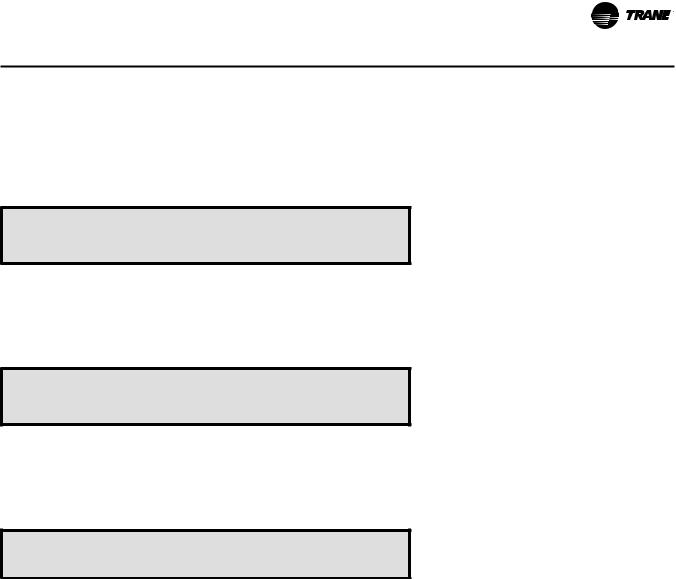
General Status Display
1.Press the + or - keys in this sequence ( + - - + ) to lock each VOM Mode.
2.Press the Enter key to confirm the password and Lock the definitions.
Diagnostic Reset is Password Protected
Please Enter Password: ____________
1.Press the + or - keys in this sequence ( - + + ) to access this restricted screen.
2.Press the Enter key to confirm the diagnostic reset.
Diagnostic Log is Password Protected
Please Enter Password: __________
1.Press the + or - keys in this sequence ( - + + -) to access this restricted screen.
2.Press the Enter key to confirm clearing the diagnostic log.
Turning Parameters are Password Protected
Please Enter Password: __________
1. Contact Clarksville Service for Password.
Navigating the Human Interface Screens
In the following sections the user will be presented with a number of screens and submenus that follow the selection of a main menu key entry (Status, Setpoints, Diagnostics, Setup, Configuration, Service Mode and Custom).When a submenu is presented, it may be accessed by pressing the Enter key or, skipped entirely by pressing the Next key. Upon entering a menu, or submenu, the user will navigate through the desired selections by pressing the Next and Previous keys.The most probable keystroke would be to press Next to cycle forward through the screens as shown in these sections, but pressing the Previous key may be desirable to review previous screens or to quickly navigate to the end of a menu.
Once the user has navigated to a desired selection, the + (Plus) and - (Minus) keys will be pressed to cycle through the selection range of the menu item.The range of each item selected is dependent upon the item and is listed for each screen in the following sections. For instance, if the user has selected a Configuration item typical choices displayed with each + (Plus) or - (Minus) keystroke may be Installed or Not Installed. If a Setup menu were accessed a choice may be Enabled or Disabled.Temperature Setpoints will typically cycle through their range one degree at a time, and so on. Similar to pressing the Previous key above, pressing the - (Minus) key to decrement through the range may provide quick access to the desired value.
Once a change has been made to the desired menu item the user will press the Enter key to accept the change, or press the Cancel key to ignore the modification and return the displayed item to its original value.
RT-SVP07D-EN |
25 |
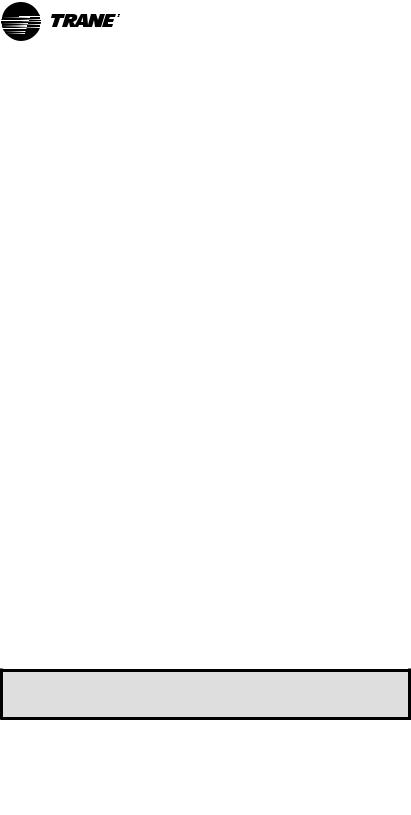
STATUS Menu
The status menu is used to view various operating conditions such as temperatures, pressures and humidity levels. It is also used to view unit component status such as fan, compressor, heater, and economizer operation, as well as setpoint status.
The screens shown in this section are for example only. Pressing the + (Plus) key while viewing any of the status display screens will add that screen to the Custom menu. While viewing the Custom menu, a screen can be removed by pressing the – (Minus) key.
When a status screen is displayed for 30 minutes without a key being pressed, the LCD screen will revert to the general operating status display. If this happens, press the Status key again to return to the status menu.The following are examples of status screens that may be viewed by pressing the Status key.
Note:
1.Many of the screens displayed in this section are applicable only for the options that are installed in the unit and may not be visible on your unit.
2.The range for some selections depend upon a sensor connected to a control module. Normal ranges expected will be listed for each screen shown. If the sensor is operating outside its normal limits, or has failed, “+ERR” will appear if out of range high, and “-ERR” if it is out of range low.
Press the Status key to begin viewing the status screens.
TOP LEVEL STATUS SCREEN
VVDA OA Flow |
350.0 CCFM Supply Fan ON |
|
|
Occupied |
Cool 4 |
Diagnostics |
|
|
|
|
|
• Press Next/Previous keys to navigate. |
|
|
|
GENERAL SYSTEM STATUS SUBMENU SCREENS |
|||
|
|
Used With: All Units |
|
General System Status Submenu |
|
||
Press ENTER to View Data in this Submenu |
|
||
|
|
|
|
• Press Next key to skip this Submenu. |
|
|
|
Active Unit Control Source: LOCAL
Active Cluster Member Role: STANDALONE
• Press Next/Previous keys to navigate.
Used With: BAS Interface Installed
Possible Values:
Source: LOCAL, BAS/NETWORK
Role: STANDALONE, SLAVE, MASTER
RTM |
Supply |
Fan Relay: |
OFF |
RTM |
Supply |
Airflow Proving: |
FLOW |
|
|
|
|
• Press Next/Previous keys to navigate.
Note: One of the three following screens will be shown based on supply air pressure options.
Used With: All Units
Possible Values:
Fan Relay: ON, OFF
Airflow Proving: FLOW, NO FLOW
26 |
RT-SVP07D-EN |
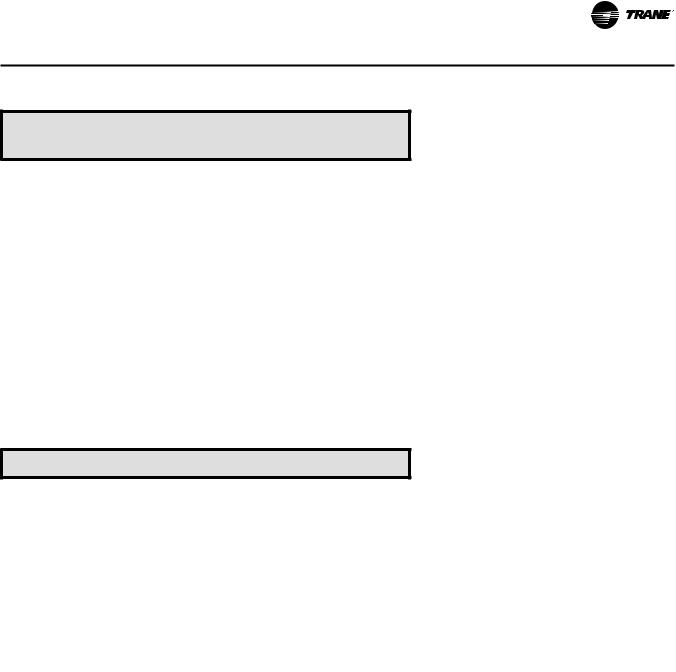
STATUS Menu
Supply Fan IGV/VFD Target: |
30% |
Master’s Algorithm Command to All Units
OR
Supply |
Fan IGV/VFD Cmd Opening To 30 % |
|
Active |
Supply Air Pressure |
2.0 IWC |
|
|
|
“Opening To” and ”Closing To” indicate direction. “Limited To” when shown indicates an active override.
OR
Active Supply Air Pressure |
2.0 IWC |
|
|
• Press Next/Previous keys to navigate.
Used With: Clustered VVDA Units
Possible Values: 0 to 100%
Used With: VVDA Units
Possible Values:
Cmd: 0 to 100%
Press: 0.0 to 7.9 IWC
Used With: CVDA/CVZT Units
Possible Values: 0.0 to 7.9 IWC
Note: One of the three following screens will be shown based on power exhaust options.
Exhaust Fan OFF
OR
Exhaust Damper/VFD |
Target: |
70 |
% |
Master’s Algorithm Command to All Units |
|
||
|
|
|
|
|
OR |
|
|
|
|||
Exhaust Fan ON Space Pressure 0.00 IWC |
|||
Exhaust Damper/VFD |
Opening To |
32 |
% |
|
|
|
|
“Opening To” and ”Closing To” indicates direction. “Limited To” when shown indicates an active override.
• Press Next/Previous keys to navigate.
Note: One of the four following screens will be shown based on heating type options.
Used With: Units w Power Exhaust w/o Statitrac, w/o Return Fan
Possible Values: ON, OFF
Used With: Clustered, w/Statitrac, w/o Return Fan Units
Possible Values: 0 to 100%
Used With: Units w/Statitrac, w/o Return Fan
Possible Values:
Fan: ON, OFF Pressure:
IPakI: -0.2 to 0.3 IWC IPakII: -0.67 to 0.67 IWC
Damper/VFD: 0 to 100%
RT-SVP07D-EN |
27 |
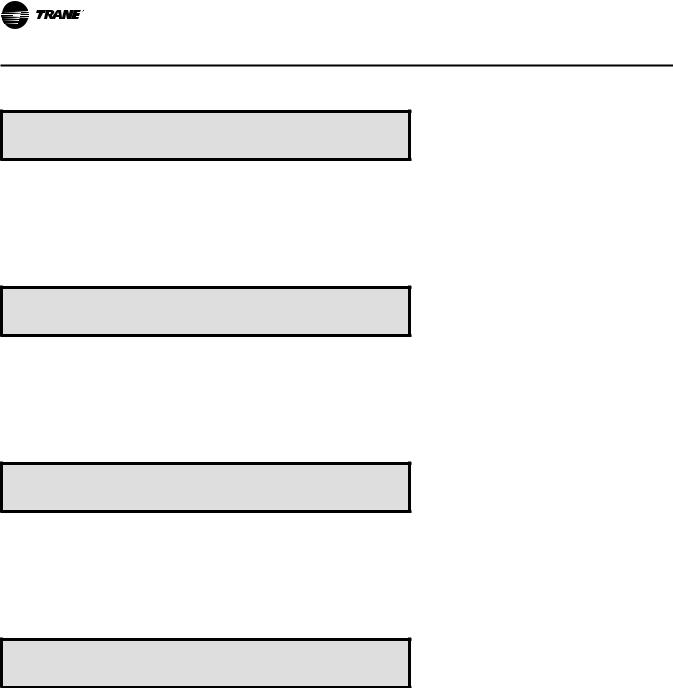
STATUS Menu
Electric Heat: ENABLED
Stage: 6 K11: ON |
K12: ON |
K1: ON |
“ENABLED” indicates heat is available. “DISABLED” indicates heating is not allowed.
“LIMITED” indicates heating is available at reduced capacity.
OR
Gas Heat: ENABLED |
|
|
Stage: 2 K11: ON |
K12: ON |
K1: ON |
“ENABLED” indicates heat is available. “DISABLED” indicates heating is not allowed.
“LIMITED” indicates heating is available at reduced capacity.
OR
Hydronic Heat: ENABLED
Valve Position: Opening To: 100 %
“ENABLED” indicates heat is available. “DISABLED” indicates heating is not allowed.
“LIMITED” indicates heating is available at reduced capacity. “Opening To” and ”Closing To” indicates direction.
OR
Mod Gas Heat: ENABLED
Valve Position: Opening To: 100 %
“ENABLED” indicates heat is available. “DISABLED” indicates heating is not allowed.
“LIMITED” indicates heating is available at reduced capacity. “Opening To” and ”Closing To” indicates direction.
• Press Next/Previous keys to navigate.
Used With: Units w/Electric Heat
Possible Values:
Electric Heat:
ENABLED, DISABLED By Setup,
LIMITED By Demand Limit DISALBED By BAS/Network
Stage: 0,1,2,3,4,5,6 K*: ON, OFF
Used With: Units w/Staged Gas Heat
Possible Values: Gas Heat:
ENABLED, DISABLED By Setup,
LIMITED By Demand Limit
DISALBED By BAS/Network
Stage: 0,1,2
K*: ON, OFF
Used With: Units w/Hydronic Heat
Possible Values:
Hydronic Heat:
ENABLED, DISABLED By Setup,
LIMITED By Demand Limit
DISABLED By Low Air Temp DISALBED By BAS/Network
Position: 0 to 100%
Used With: Units w/Mod Gas Heat
Possible Values:
Mod Gas Heat:
ENABLED, DISABLED By Setup,
LIMITED By Demand Limit
DISABLED By Low Air Temp DISALBED By BAS/Network
Position: 0 to 100%
28 |
RT-SVP07D-EN |
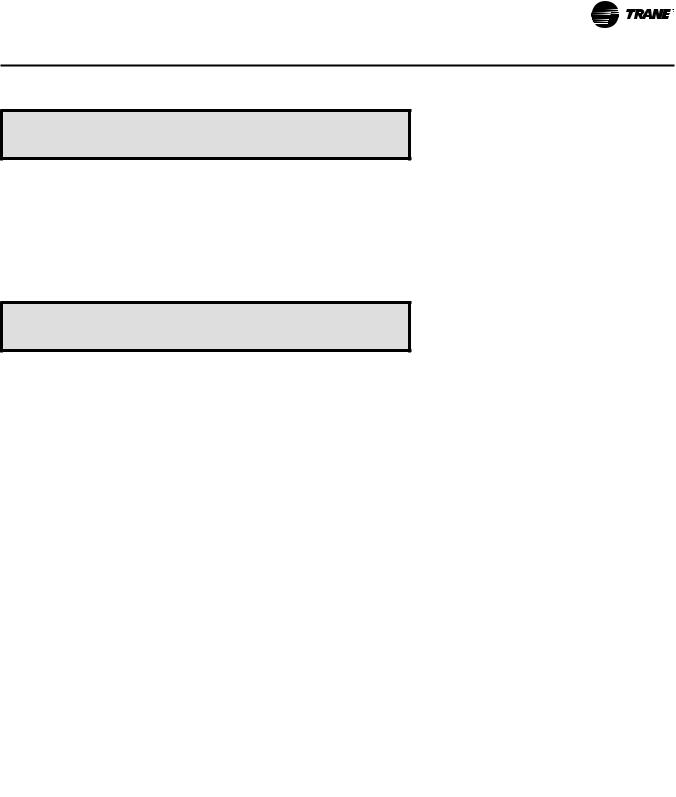
STATUS Menu
Chilled Water: ENABLED
Valve Position: |
Opening To |
100 % |
“ENABLED” indicates cooling is available. “DISABLED” indicates cooling is not allowed.
“LIMITED” indicates cooling is available at reduced capacity. “Opening To” and ”Closing To” indicates direction.
• Press Next/Previous keys to navigate.
Dehumidification Status: |
DISABLED |
by Comfort Control Override is Active
Table 3. Dehumidification Lockout Sources
Used With: Air Handler Units w/Chilled Water
Possible Values:
Chilled Water:
ENABLED, DISABLED By Setup,
LIMITED By Demand Limit
DISABLED By Low Air Temp
DISALBED By BAS/Network
Position: 0 to 100%
Used With: Units w/Dehumidification
Top Line Possible Values: ENABLED, DISABLED
Bottom line Possible Values:
When ENABLED is Shown: (blank line)
When LOCKED is Shown:
[See “Table 3. Dehumidification Lockout Sources” Below]
Value Displayed in Bottom Field |
Disable Conditions |
|
|
Disabled By Call for Cooling Demand Limit ........................ |
Compressors unavailable due to demand limit. |
Disabled By Compressor Lockout Sources .......................... |
Required compressors are not available. |
Disabled By Occ Dehumid Function Disable ....................... |
Occupied Dehumid. control is disabled. |
Disabled By Dehumid Override Zone Temp High/Low .......... |
VVDA/CVDA critical zone temp is too high/low. |
Disabled By OA Temperature Out Of Range ....................... |
Outdoor air temperature is out of range. |
Disabled By Unocc Dehumid Function Disable..................... |
Unoccupied Dehumid. control is disabled. |
Disabled By Comfort Control Override is Active................... |
Comfort cooling control has priority. |
Disabled By Required Sensor Failure Condition ................... |
Sensor(s) for dehumid. control have failed. |
Disabled By Sat Reheat Cond Temp Sensor Fail .................. |
Sensor for dehumid. control have failed. |
Disabled By Reheat Head Pressure High Limit..................... |
Reheat circuit is experiencing high pressures. |
Disabled By Condenser Coil Purge is Active ........................ |
Active purge mode temporary override. |
Disabled By Comp Press Differential.................................. |
Excessive refrig. pressures across compressors. |
|
|
• Press Next/Previous keys to navigate. |
|
Humidification |
Status: |
ENABLED |
Humidification |
is Active |
|
|
|
|
• Press Next/Previous keys to navigate.
Used With: Units w/Humidification Top Right Field: ENABLED, DISABLED
Bottom Field:
The following shown when DISABLED: by Occ Humidification Function Disable by Unocc Humid Function Disable
The following shown when ENABLED: Humidification is Inactive Humidification is Active
RT-SVP07D-EN |
29 |
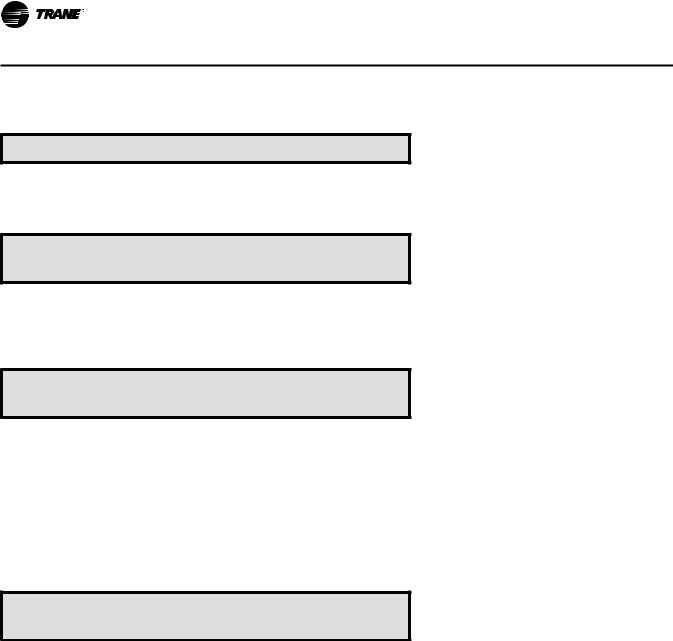
STATUS Menu
End of Submenu (NEXT) to Enter STATUS
• Press Next/Previous keys to navigate.
COMPRESSOR STATUS SUBMENU SCREENS
Compressor Status Submenu
Press ENTER to View Data in This Submenu
• Press the Next key to skip this Submenu.
Note: Combinations of the following screens will be shown based on unit cooling capacity option.
Compressor Relay K10 |
Locked |
Disabled By Compressor Protection (MORE)
Note: There will be 2 screens shown for this configuration, one screen for K10 and one for K11.
• Press Next/Previous keys to navigate.
OR
Compressor Relay K11 |
Locked |
Disabled By Compressor Protection (MORE)
Note: There will be 4 screens shown for this configuration, one for K11, one for K12*, one for K3, and one for K4*. See the following replacement screen for K12 when a variable speed compressor is installed on 40-70 ton units. K12 and K4 will show either Enabled or Activated by Compressor Protection when the compressor is ON.
Important:
•*See the following replacement screen for K12 when a variable speed compressor is installed on 40-70 ton units.
•*K12 and K4 will show either Enabled, or Activated by Compressor Protection, when the compressor is ON.
•Press Next/Previous keys to navigate.
Used With: Units w/DX Cooling
Used With: IPakI 20-30Ton DX Cooling
Possible Values: Compressor Relay:
K10: 1st Compressor
K11: 2nd Compressor
Top Right Field:
ON, OFF, LOCKED
Bottom Field:
When ON or OFF is Shown: ENABLED When LOCKED is Shown:
[See “Table 4. Compressor Lockout Sources" on page 32”]
Used With: IPakI 40-130Ton DX Cooling
Possible Values: Compressor Relay:
K11: 1st Compressor
K12: 2nd Compressor
K3: 3rd Compressor
K4: 4th Compressor
Top Right Field:
ON, OFF, LOCKED
Bottom Field:
When ON or OFF is Shown: ENABLED When LOCKED is Shown:
[See “Table 4. Compressor Lockout Sources" on page 32”]
30 |
RT-SVP07D-EN |
